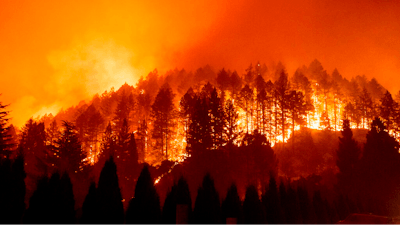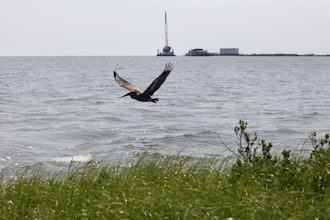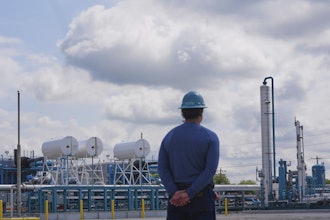
SAN FRANCISCO (AP) — Pacific Gas & Electric began turning off power to more than 50,000 Northern California customers Wednesday evening as dry, windy conditions renewed the threat of fire in a season already marked by deadly, devastating blazes.
The utility announced that it had begun cutting power to up to 33,000 customers, with about another 20,000 to follow in a few hours.
The shutoffs will affect portions of nearly two dozen counties, mostly in the Sierras and San Francisco Bay Area, and could last 48 hours.
Preemptive electricity cuts are a strategy aimed at preventing fires from being started by power lines that have been damaged or knocked down amid high winds. PG&E equipment sparked several massive blazes that destroyed tens of thousands of homes and killed more than 100 people since 2017.
“These are challenging times. Not only are we right in the peak of the wildfire season ... many of us are working from home, schooling from home as well. We recognize that hardships are introduced when we shut off power,” said Mark Quinlan, PG&E’s incident commander. “It’s our last resort option.”
The figure represents about 1% of PG&E's 5.1 million customers. The nation's largest utility said last month that it is using smarter and shorter power shutoffs after receiving widespread criticism from the public and regulators last year when it turned off electricity to 2 million people to prevent its equipment from sparking wildfires.
A second shutoff for around 700 customers was expected Thursday afternoon in far northern counties as winds were expected to arrive there.
The National Weather Service issued a red-flag warning for extreme fire danger through Friday morning in many areas. Hundreds of firefighters from across the state were being deployed to Northern California because of the weather, with bone-dry humidity and winds possibly hitting 55 mph (88.5 kph) with gusts to 70 mph (112.7 kph) possible in the Bay Area.
PG&E senior meteorologist Scott Strenfel said the forecast calls for two “back-to-back" periods when so-called Diablo winds sweep the region. In addition to high winds, they bring very dry air “and essentially suck the moisture out of vegetation," leaving it tinder-dry and vulnerable to burning.
Several of the counties falling under the PG&E shutoffs already were hit by massive wildfires.
The Glass Fire that ravaged the Northern California wine country of Napa and Sonoma counties was surrounded Wednesday after destroying more than 1,500 homes and other buildings.
Farther north, the Zogg Fire in Shasta and Tehama counties was fully contained. Four people died in that blaze.
Hot weather also prompted California's electric grid operator to issue a statewide Flex Alert, urging people to conserve energy between 3 p.m. to 10 p.m. Thursday by turning down their air conditioners and not using major appliances. Previous conservation efforts this summer were praised for reducing the power demand and avoiding rolling blackouts.
More than 8,500 wildfires have burned more than 6,400 square miles (16,000 square kilometers) in California since the start of the year, most since mid-August. Thirty-one people have died, and more than 9,200 buildings have been destroyed.
Most of the huge fires that erupted over the past eight weeks are now fully or significantly contained and skies once stained orange by heavy smoke are blue again.
But the gains made by thousands of firefighters assigned to the blazes that have scorched more than 4.1 million acres this year could be hampered if new fires ignite, said Daniel Berlant, assistant deputy director with the California Department of Forestry and Fire Protection, known as Cal Fire.
"If a new fire breaks out, that fire will be able to grow very quickly under these conditions,” Berlant said.
Denise Bethune lost her home of 12 years last month after a blaze razed her tiny foothills community of Berry Creek, about 160 miles (260 kilometers) northeast of San Francisco in rural Butte County. The night before, PG&E cut off power and she and her husband couldn't use their well to get water and hose down their home.
Bethune, who has multiple sclerosis, said cutting power is a double-edged sword because it can help prevent fires from starting but it causes other issues.
“Whenever there is a power outage, my main concern is the heat because I can't handle it without air conditioning due to my medical needs," she said.
Since being displaced, Bethune, her husband and three dogs have been living in a trailer they parked on her son’s orchard near the city of Chico that has its own power source.
PG&E’s aging equipment has sparked several major fires in recent years, including a 2018 blaze that destroyed much of the town of Paradise and killed 85 people. The utility pleaded guilty in June to 84 felony counts of involuntary manslaughter — one death was ruled a suicide — and paid $25.5 billion in settlements to cover the losses from that and other recent power line-sparked catastrophes.
Numerous studies have linked bigger wildfires in America to climate change from the burning of coal, oil and gas. Scientists have said climate change has made California much drier, meaning trees and other plants are more flammable.
Experts say nine out 10 wildfires are caused by people either accidentally or deliberately.






















